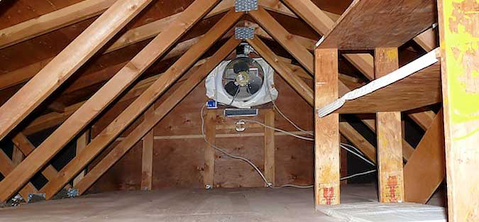
The warmer weather we’re experiencing in Santa Barbara this year, with new record highs almost every month, is making many think about how to stay cool in our homes. Usually the first thought is to get air conditioning. Another option worth considering is the whole-house fan.
This attic-mounted fan exhausts air at night, specifically to cool the house when the heat of the day has passed and the outdoor temperature has dropped enough to feel comfortable — below 75 degrees or, better yet, below 70.
The main advantage of a whole-house fan over an air conditioner is the energy savings; the fan draws just 10 to 15 percent of the power used by a central air conditioner. (Whole-house fans are intended to be used in homes that are not air-conditioned.) Whole-house fans also cost a fraction of typical air conditioners and are less disruptive to install in an existing home.
In most cases, a whole-house fan is mounted in the attic floor over a central hallway. Once the outdoor air temperature cools down in the evening, the homeowner opens a few downstairs windows (be sure to have the fireplace damper closed) and turns on the fan. The fan pulls air from the hallway and blows it into the attic, and then outside through attic vents. Since whole-house fans are relatively powerful, they quickly exhaust the hot indoor air, often in as little as an hour, allowing cooler outdoor air to enter through the open windows. Once the house has cooled off, the fan can be turned off and the windows closed.
Ideally the fan switch has a timer or thermostatic-control element for automatic shutoff. Most people who have whole-house fans keep their windows closed from early morning until evening so that cool air inside the house doesn’t escape.
Whole-house fans are most effective in dry climates with cool nights, exactly what we enjoy here on the South Coast. Because they can depressurize a home, an installer must make certain that, if there is an atmospherically vented furnace or water heater in the house, there is no risk of backdrafting — a serious safety issue.
These fans create a big hole in the ceiling, which will leak a lot of heat in winter unless properly sealed. The best solution is to buy a unit with motorized insulated doors. Tamarack Technologies makes the best fans with tight sealing doors. They range in price from $600-$800. This brand’s fans also tend to use less energy and are quieter than other brands.



